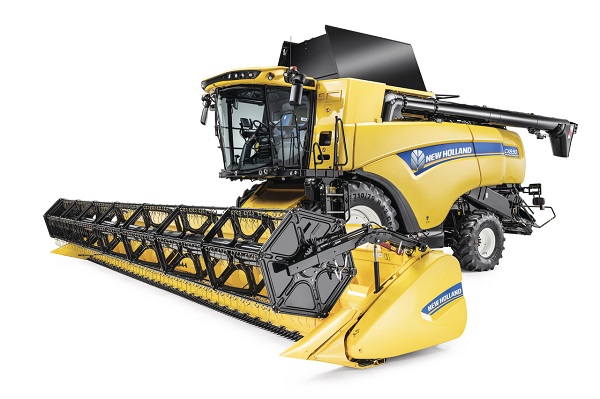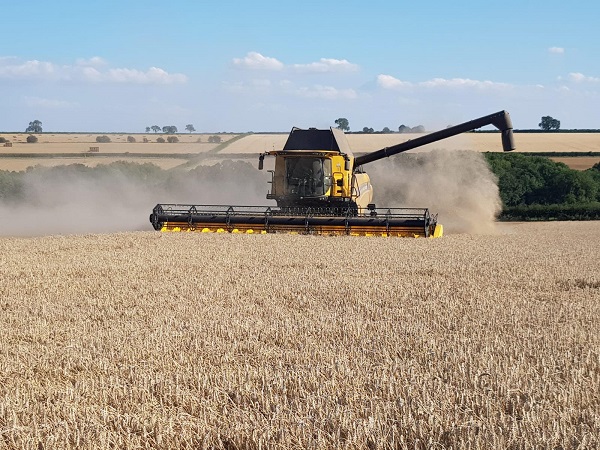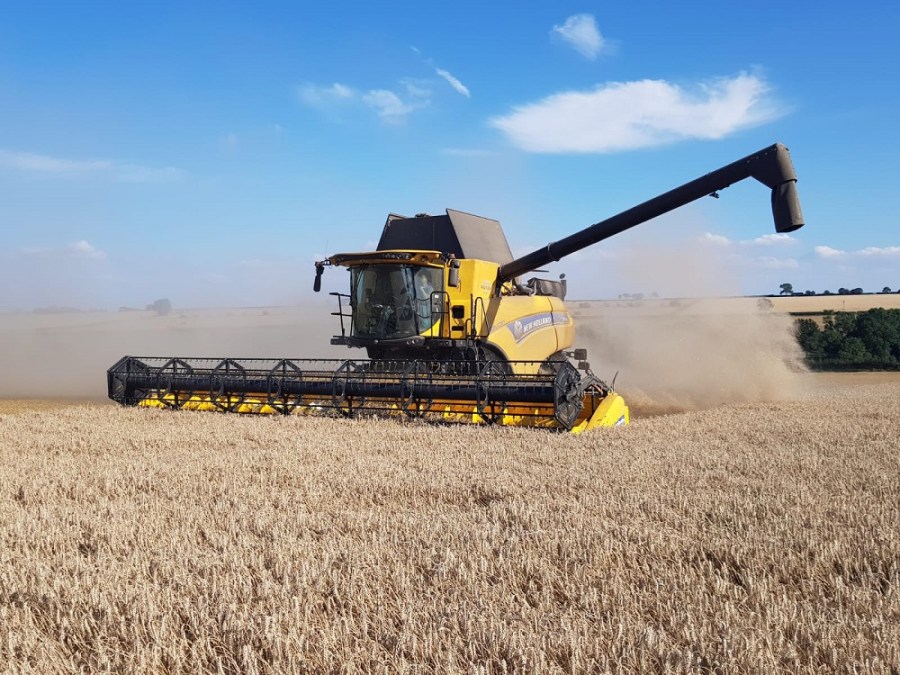If there’s any piece of kit that should be as efficient as possible, it’s the combine harvester. CPM visits a farm in Rutland to find out how switching manufacturers and investing in a new machine is helping the business secure its future.
There was something about the simplicity of the CR9.80 that made me feel I could actually deal with any issues
By Charlotte Cunningham
Tea or coffee; brown or white; jam or marmalade – we all have our favourites. These small but significant preferences become such a regular part of our routine that we’re often reluctant to stray from the norm. However, just because something is tradition is no reason to do it, of course.

The old combine didn’t spread anywhere near as accurately and the CR seems to chop it better.

Nestled in the heart of Rutland on a late August morning, Tom Gilman is fueling up his combine with hopes of getting started on wheat harvest in what has been a very stop-start year.
With the bright yellow and blue paint work still gleaming and razor-sharp blades, it’s not hard to tell that this piece of kit has not been long off the production line.
Slightly bleary eyed from the late nights that are all too familiar at this time of year, Tom pauses to take a tentative sip of piping hot tea. This is the way he starts every morning, before moving to coffee in the afternoon, and little could change this. However, he takes a much more pragmatic approach when it comes to his choice of combine brand.
Coppice Farm (run alongside Manor Farm), is home to a flock of over 5000 sheep but for Tom, the focus is on the arable side of things with winter wheat, winter barley, spring wheat, spring barley, oilseed rape and sugar beet grown on an annual basis.
One of the key pillars in Tom’s business model is efficiency and keeping cost of production as low as possible to push margins. With the longevity of machinery having a large influence over cost and efficiency, when the opportunity presented itself to invest in a new combine harvester, this principle was a key factor in his decision making. “I like to keep my kit for as long as possible and with on-site mechanics who undertake regular maintenance of the equipment, I aim to keep a combine for about 10 years.”
Like most of us, Tom admits to being a stickler for tradition and has – up until now – been with the same manufacturer for a number of years.
However, with his previous two combines only making it to seven years of age after unfortunately getting written off by insurers due to major mechanical faults and damage, Tom started looking at other options to help increase the lifespan of his investment.
“In 2017, I started looking at what was on the market and had two demos over two seasons. One of these was a New Holland – a brand I’d never used before,” he explains.
With a number of crops grown on a very varying soil type, from limestone brash to red land loam and boulder clay, it was crucial to invest in something that would be able to handle all situations and terrains but also ticked the box of keeping the cost of production as low as possible, adds Tom. “My long term vision is to keep costs down – especially my fixed costs. When it comes to purchasing equipment, I’m not a fan of big shiny kit – it’s normally expensive and it doesn’t necessarily mean it’ll do the job you want it to.”
Following his two years of demo’s, Tom took a leap of faith and invested in the New Holland CR9.80 – with a 10.5m header – which has now almost completed its inaugural harvest on farm.
Brand loyalty is something farmers are very familiar with, often causing jesting between workmates as to whether you’re Team Green, Red, Yellow, Blue or any other colour for that matter. So what was it that swung it for Tom that made him leave one camp and invest in a big yellow piece of kit for the new season?
“The New Holland felt a lot simpler to manage,” he explains. “There was something about the simplicity of the CR9.80 that made me feel I could actually deal with any issues as a farmer, rather than relying on a mechanic.”
Specifically, Tom has noticed this in tasks such as changing belts. “Beforehand, this was never a five-minute job and resulted in a lot of downtime. Being able to carry out jobs like this quickly and efficiently all adds to the longevity of a machine, meaning I’ll be able to keep it for longer.”
According to Tom, the 10-year milestone is incredibly crucial for keeping costs down. “Because of the way I purchase kit, the first five years of ownership is what costs me the most money, so I need a combine to last until around 10 years in order to get this payback.”
As well as the ease of maintenance, another feature which has proven to be a benefit is the IntelliSense system, despite initial concerns over how useful it would really be. “I bought the IntelliSense as an added extra, but if I’m being honest, I thought it was a bit of a gimmick. A lot of combine drivers out there would argue that there is an art to operating a combine that technology can’t replace. But having used it this year, I really am impressed.”
Other things Tom has noticed include better preservation of the straw and more even spreading. “The CR doesn’t seem to smash up the straw as much. When we were cutting barley we definitely noticed it leaving a very nice swath for the baler boys.
“I’ve also noticed a massive improvement within the chopper and spreader. Our old combine didn’t spread anywhere near as accurately and the CR seems to chop it better, too. Spreading it over the full 10.5m cut, the following cultivations will have less of a problem.”
Operators outlook
While Tom holds the purse strings when it comes to new purchases, it’s operator, Nigel Mould, who does the bulk of the driving. We sat down with him to find out exactly what the pros and cons of the New Holland combine are.
“I’ve been driving for around 40 years now, so it’s fair to say I have a little bit of experience in terms of what makes a good combine,” he grins. “I started on a Massey Ferguson before moving to a Deutz Fahr and then a Claas, and now I’m driving a New Holland, so there’s a lot there to compare to.”
Nigel echoes Tom’s views in terms of the ease of maintenance being a real seller for the CR9.80, but also really likes overall ‘cleanliness’ of the machine. “Most combines get really dusty which can create a fire hazard – not ideal when you’re cutting in hot, dry weather,” he explains. “However, I’ve found that this bit of kit keeps fairly dust free, which as a combine driver is great as it means there’s less for me to blow down.
“In terms of maintenance, I think there are only about 15 grease points, so it’s very straight forward.”
However, the number one selling point, according to Nigel, is the IntelliSense feature. “It’s a pretty unique device. It does slightly take the art out of combining, but it’s very beneficial.
“Particularly in laid crops, you can concentrate solely on driving without having to worry about anything else and it also gives a very good sample.”
The addition of GPS is also another plus point, he adds. “On the previous combine we had the LaserPilot system but it was a bit temperamental. The CR’s GPS is a really nice bonus.”
Very few things in life are completely perfect, and if he could change anything, Nigel says he’d like a little more control over the cutting knife. “I think it could do with a switch to alter the cutter knife a fraction, rather than just up or down. It’s a little bit erratic on the knife settings.”
When asked if there were any teething problems with the latest purchase, Nigel says the only real issue was the controls being in the opposite place to where he was used to. “I’m glad I figured that out pretty quickly,” he chortles.
Features of a record-breaking machine
Introduced by New Holland in 2018, the CR9.80 is a 571hp rotary combine.
As well as a popular choice with growers, the CR holds the current harvesting record after cutting 797.65t of wheat in under eight hours back in 2014, demonstrating the power and capacity within the range, says New Holland.
Boasting grain tank storage of up to 12,500 litres, New Holland claims to be able to improve capacity by up to 15% with the optional Dynamic Feed Roll feature with integrated stone protection.
In the guts of the combine is an FPT Industrial Cursor 13, Stage 4 engine, while Twin Rotor technology is said to help preserve grain and straw quality, with an average grain-crackage figure of 0.1%.
Standard features include remote adjustable deflectors, automatic concave reset and the Opti-Clean cleaning system, while growers also have the option to upgrade their kit to include features like the SmartSteer or IntelliSteer automatic guidance system, yield and moisture measuring, and the Opti-Spread residue management system.
The spec
Header
Cutting width: 6-12.5m
Knife speed (standard): 1150 cuts/min
Reel diameter: 1m
Rotors
Diameter: 56cm
Length: 2.6m
Length of auger section: 39cm
Length of threshing section: 1.1m
Length of separation section: 42cm
Beater
Width: 18.5m
Diameter: 4.7m
Total threshing and separation area: 12.2m²
Intelligence on IntelliSense
With both Tom Gilman and Nigel Mould particularly pleased with the added IntelliSense system on the CR, we want to know – what makes it so great?
“Have you ever wondered why two identical combines can perform so differently in the same field?” asks Nigel Honeyman, harvest product manager for New Holland UK. “Over the years we’ve changed a number of things on our combine ranges but the variable that hasn’t been considered is the operator.”
“What we’ve introduced with the IntelliSense system is the ability for the combine to continually monitor and improve its performance.”
While the operator is still in control, and sets the strategy – whether that be to maintain or maximise throughput, to reduce losses or to get the best sample from the grain tank – this means farmers have the ability to get the best out of the machine, adds Nigel.
IntelliSense is powered by a combination of features – including a camera to monitor the quality of the grain going into the tank and a pressure sensor on the cleaning shoe to monitor where losses are actually occurring – and checks every 20 seconds to see whether or not it can optimise its own settings.
The system comes into its own when there is a perhaps less experienced member of staff behind the wheel, according to Nigel. “With an inexperienced operator, testing has proved that we can increase his output by over 20% throughout the day with the IntelliSense system.
“Even when tested on experienced drivers, we have also been able to improve output by 10%.”
Farm facts
Coppice Farm, Glaston, Rutland
- Crops: Winter wheat, winter barley, spring wheat, spring barley, OSR and sugar beet
- Tractors: 2x Massey Ferguson 8740; 3x John Deere 7810; JD 8410; JD 6150R
- Cultivations: 4.5m SumoTrio; Horsch Terrano GX; mole plough; Cousins flat lift; 3x Knight triple presses and a variety of DP7 ploughs.
- Soil type: Limestone brash to red land loam down to boulder clay.
- Staff: Three full time tractor drivers, three shepherds and one mechanic.




